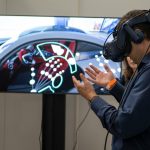In the realm of virtual reality (VR) game development, horror genre holds a unique position. It nudges the boundary of immersive gaming towards the extremes of sensory experiences. It is here that visual elements, particularly adaptive lighting, come into play. Lighting conditions in horror VR games significantly influence the gaming experience, setting the mood, creating suspense, and amplifying fear elements. Adaptive lighting does even more by dynamically altering the environment according to the player’s actions, decisions, or game progression, immersing the player deeper into the virtual world.
Let’s delve into the best practices for implementing adaptive lighting conditions in horror VR games, exploring the principles of effective lighting, procedural lighting techniques, balancing darkness and visibility, user comfort consideration, and the role of advanced technology.
Topic to read : How can AI be used to create more realistic underwater physics in diving simulation games?
Principles of Effective Lighting
Understanding the principles of effective lighting is essential for creating immersive VR experiences. Traditionally, lighting in video games is used to guide players, highlight objects of interest and create a mood or atmosphere. In horror VR games, this takes on a more nuanced role.
Effective lighting in horror VR games often relies on strategic use of light and shadow, sophisticated visual cues, and a solid understanding of the player’s perspective. The contrast between light and dark areas can generate suspense and fear, while the direction, color, and intensity of light can evoke specific emotional responses. Additionally, considering the player’s field of vision and using light to subtly direct attention can enhance the feeling of immersion and presence.
Also to discover : How can developers use machine learning to create dynamic in-game weather patterns?
Procedural Lighting Techniques
The next step is to understand and apply procedural lighting techniques, which are a key component of adaptive lighting. Procedural lighting involves dynamically generating and altering lighting conditions in real-time based on predefined algorithms or the player’s actions.
For instance, a torch carried by the player can lighten the surroundings and cast moving shadows, which can heighten the sense of realism and tension. Similarly, flickering lights, sudden blackouts, or encroaching darkness can be procedurally triggered in response to the player’s progress or actions.
Such techniques, when deployed carefully, can ramp up players’ anxiety levels, inducing a genuine sense of horror. It’s important to remember, however, to balance these techniques to avoid overuse, which can desensitize the player to their fear-inducing effects.
Balancing Darkness and Visibility
In horror VR games, darkness is not just the absence of light, but a vital tool to create tension and fear. However, too much darkness can lead to frustration and discomfort. Therefore, balancing darkness and visibility is a crucial challenge.
The best practices involve using darkness strategically to obscure certain details and compel the players to explore. However, essential game elements or paths should not be completely hidden. Shadows and partial lighting can be used to hint at the possible presence of something, leaving the rest to the player’s imagination, which often amplifies the fear factor.
Also, employing different types of lighting such as ambient, diffuse, and specular can help maintain visibility while preserving the eerie atmosphere, thereby enhancing the game experience.
User Comfort Consideration
While implementing adaptive lighting, it’s important to remember that VR is an intensely immersive medium, and user comfort should not be compromised. Abrupt changes in lighting can cause discomfort, ruin immersion, and potentially induce ‘VR sickness’.
To mitigate these issues, transitions in lighting should ideally be smooth and gradual. In addition, implementing a ‘comfort mode’ option that allows players to adjust brightness levels or limit drastic lighting changes can be beneficial. It’s also vital to regularly test the game on a variety of users to identify any potential comfort issues and adjust the lighting accordingly.
The Role of Advanced Technology
As VR technologies evolve, more opportunities are emerging for implementing adaptive lighting in innovative ways. Advanced graphics rendering techniques, such as ray tracing, can enable realistic light propagation, reflection, and scattering, which can significantly enhance the visual realism and immersion of horror VR games.
Furthermore, machine learning algorithms can be used to analyze player behavior and adapt lighting conditions in real-time to maximize fear induction. For example, if a player tends to avoid dark areas, the game could dynamically darken well-lit areas or lighten dark corners to throw the player off balance and increase the element of suspense.
While implementing adaptive lighting conditions in horror VR games, remember to strike a balance between inducing fear and maintaining user comfort, employing advanced technology while adhering to the fundamentals of lighting design. This way, you can craft truly immersive, terrifying, and enjoyable horror VR game experiences.
The Importance of Lighting Design in Horror Games
Just as in film and photography, lighting design is crucial in video games, and even more so in horror VR games. It is not just about illuminating the environment, but also about manipulating the player’s emotions and shaping their experience. Effective lighting design can elevate a VR horror game from a simple distraction to a truly terrifying, immersive experience.
In designing the lighting for horror VR games, developers should consider a few key elements. Firstly, the contrast between light and dark areas. By manipulating this contrast, developers can create suspense and a sense of fear. A sudden transition from a well-lit area to a pitch-black room can evoke a sense of dread, while a subtly lit corridor can create anticipation.
Secondly, the direction of light is another crucial element. Light coming from unexpected or unnatural directions can disorient the player and increase their anxiety. For example, a light source coming from below can distort shadows and create an eerie, unsettling environment.
Lastly, the color and intensity of the light can also evoke specific emotions. Warmer colors such as red and orange can evoke a sense of danger, while cooler colors like blue and green can create a calm but eerie atmosphere. Intense, harsh lighting can create a sense of alertness, while soft, diffused lighting can create an ominous, suspenseful mood.
In addition to these elements, it’s also important to adhere to the fundamentals of lighting design. This includes understanding how light behaves in real life, and accurately replicating this in the virtual environment, which can be achieved through advanced techniques such as ray tracing.
Engaging Players with Adaptive Lighting
Adaptive lighting is a technique that allows for dynamic changes in lighting conditions in response to the player’s actions, decisions, or game progression. This can help create a more immersive and engaging experience for players.
In horror VR games, adaptive lighting can be used to ramp up the tension. For instance, if a player enters a previously well-lit room only to have the lights suddenly flicker and go out, this can create a real sense of fear. Similarly, if a torch carried by the player illuminates an otherwise dark environment, the moving shadows and shifting light can create a feeling of uncertainty and suspense.
Advanced technology, such as machine learning algorithms, can also be used to adapt the lighting conditions in real-time based on player behavior. For example, if the algorithm detects that a player tends to avoid dark areas, it could dynamically darken well-lit areas or lighten dark corners to increase the feeling of unease and suspense.
In conclusion, implementing adaptive lighting in horror VR games is a complex but rewarding process. It requires a solid understanding of lighting design principles, a creative approach to procedural lighting techniques, and a keen eye for balancing darkness and visibility.
Moreover, developers should prioritize user comfort, ensuring that the lighting transitions are smooth and gradual, and allowing players to adjust brightness levels as needed. Advanced technology, such as ray tracing and machine learning, can further enhance the realism and immersion of the game experience.
Ultimately, the goal of adaptive lighting in horror VR games is to create a truly immersive, terrifying experience for the player. By skillfully manipulating light and shadow, developers can evoke powerful emotions, guide the player’s attention, and shape their journey through the virtual world.
By following these best practices, developers can push the boundaries of the horror genre, creating games that are not just fun to play, but also deeply engaging and emotionally resonant.






